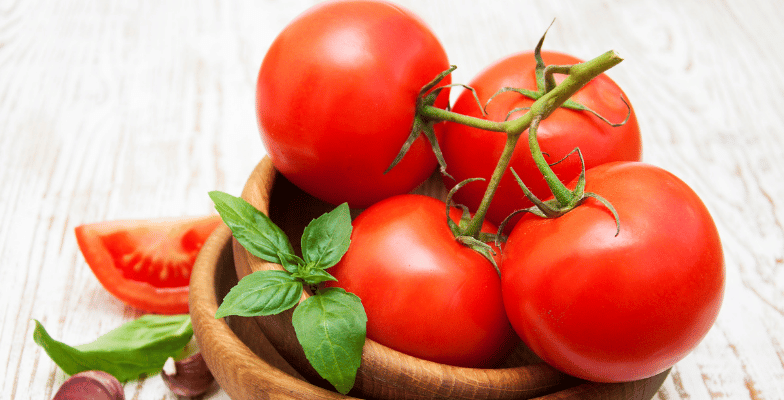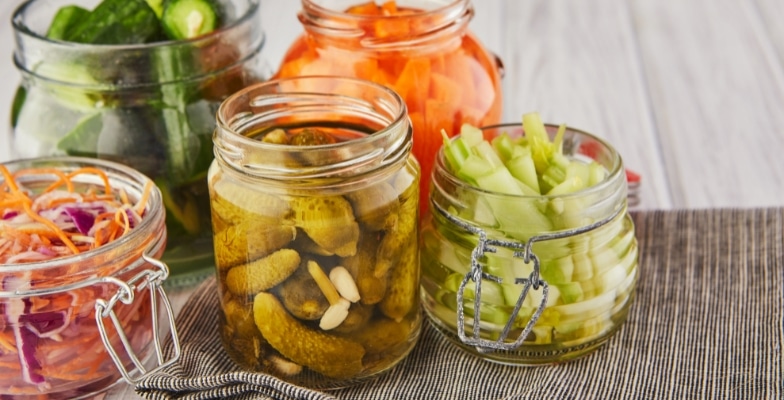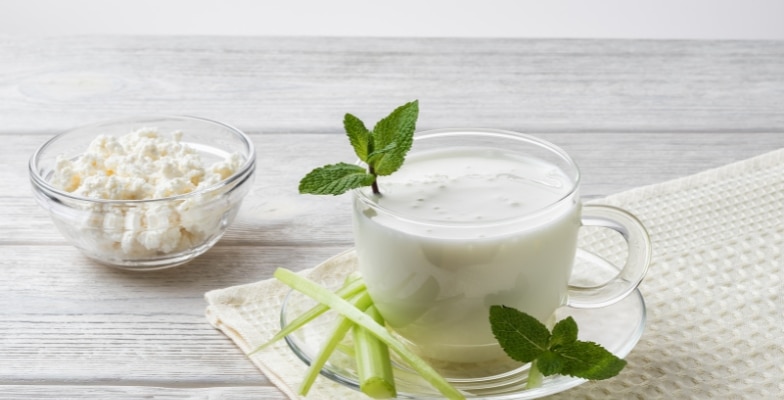Tomatoes Nutrition Facts | Health Benefits Of Tomatoes
- Introduction
- Is Tomato A Fruit Or A Vegetable?
- Health Benefits Of Tomatoes
- Types Of Tomatoes
- Possible Risks
- Conclusion

Introduction
Knowledge is knowing that a tomato is a fruit; wisdom is not putting it in a fruit salad.
~Miles Kington
Tomatoes add sweetness and acidity to any savory dish. But why are they never added to a fruit salad? Are tomatoes fruits or vegetables? Very genuine questions, and I always wondered but never looked deeply into them until now.
The tomato is the edible red berry of the plant Solanum Lycopersicum, commonly known as the tomato plant. The species originated in western South America and Central America and is now one of the most common commercial crops grown widely in temperate climates worldwide.
Is Tomato A Fruit Or A Vegetable?
The botanical classification of fruits and vegetables is based on the structure and function of the edible part of the plant. The word fruit comes from the Latin fructus or frui, meaning to enjoy, and according to Merriam-Webster, a fruit is:
The usually edible reproductive body of a seed plant.
The tomato plant is a seed plant. It bears seeds, and the part we eat is an edible reproductive body. The plant reproduces with the seeds inside the tomato. 1https://www.merriam-webster.com/words-at-play/fruit-vs-vegetable
The word vegetable comes from the Latin word vegetabilis, which means growing (as in plants) and is any plant or vegetable matter. The term vegetable usually refers to the fresh edible portions roots, stems, leaves, flowers, fruit, or seeds- of certain herbaceous plants.
Scientifically speaking, a tomato is a fruit. When it comes to cooking, fruits and vegetables are categorized differently. In the culinary world, it’s done based on flavors.
Culinarily speaking, a vegetable usually has a chewier texture, tastes blander and often requires cooking when used in dishes like stews, soups or stir-fries.
On the other hand, the fruit has a soft texture, tends to be either sweet or tart, and is often enjoyed raw or in desserts or jams. So in the culinary world, a tomato is a vegetable. The USDA lists tomatoes as vegetables. 2https://www.choosemyplate.gov/tomato-raw-do-not-use
Health Benefits Of Tomatoes
May Protect Against Cancer
Tomatoes are an excellent source of vitamin C and other antioxidants, including alpha-lipoic acid, lycopene, choline, folic acid, beta-carotene, and lutein. These compounds can help prevent the formation of free radicals that are known to cause cancer. 3https://www.cancer.gov/about-cancer/causes-prevention/risk/diet/antioxidants-fact-sheet
Recent public health studies suggest a potential benefit of beta carotene and lycopene (the compound that gives tomatoes their color) in lowering the risk of prostate cancer, particularly the more lethal forms. Five studies show a 30% to 40% reduction in risk associated with tomato or lycopene consumption. 4https://pubmed.ncbi.nlm.nih.gov/10050865/, 5https://pubmed.ncbi.nlm.nih.gov/15949687, 6https://pubmed.ncbi.nlm.nih.gov/12424325/
Helps Protect Skin
The benefits of tomatoes for the skin are attributed to three high-powered antioxidants: carotenoids, vitamin E, and vitamin C. Harsh ultraviolet rays can lead to wrinkles, sagging skin, blemishes, and other adverse effects.
Studies have found that dietary carotenoids in tomatoes may reduce UV damage to the skin, lowering the risk to the skin from sunburn and ultraviolet (UV) light-induced erythema. 7https://www.ncbi.nlm.nih.gov/pmc/articles/PMC5506060/, 8https://pubmed.ncbi.nlm.nih.gov/16465309/, 9https://pubmed.ncbi.nlm.nih.gov/15830922/, 10https://pubmed.ncbi.nlm.nih.gov/11340098/ This does not mean we can stop taking care of our skin in the sun if we eat tomatoes, but tomatoes may provide added protection.
Improves Heart Health
The fiber, potassium, vitamin C, lycopene, and choline in tomatoes all support heart health. 11https://pubmed.ncbi.nlm.nih.gov/22158914/, 12https://pubmed.ncbi.nlm.nih.gov/23045517/ A cup of tomato contains 426 mg of potassium and 9 mg of sodium. Increased potassium intake and decreased sodium intake are associated with a reduced risk of cardiovascular disease. 13https://www.heart.org/en/health-topics/high-blood-pressure/changes-you-can-make-to-manage-high-blood-pressure/how, 14potashttps://pubmed.ncbi.nlm.nih.gov/16569044/
Potassium may also protect muscles against damage, improve bone mineral density, and reduce kidney stone formation. 15https://ods.od.nih.gov/factsheets/Potassium-HealthProfessional/#h7 Tomatoes are one of the crucial ingredients in a healthy Mediterranean diet.
Many recent studies have found that people who regularly consume the Mediterranean diet may have lower death rates from heart disease and cancer. 16https://www.cardiosmart.org/news/2018/7/study-confirms-the-heart-health-benefits-of-a-mediterranean-diet
Research from the Harvard School of Public Health, which followed more than 39,000 women for seven years, found an association between the consumption of tomato-based and cardiovascular benefits. 17https://www.health.harvard.edu/heart-health/why-the-mediterranean-diet-is-so-good-for-your-heart#:~:text=A%20study%20published%20this%20February,a%20regular%20low%2Dfat%20diet.
Total Health Benefits
Tomatoes are often described as a laxative fruit as they have high water, fiber, and naringenin (a natural flavonoid) content. 18https://www.ncbi.nlm.nih.gov/pmc/articles/PMC5752176/ Studies suggest that people with a proper dietary intake of the carotenoids lutein and zeaxanthin (present in tomatoes) have a 35% lower risk of getting neovascular AMD. 19https://www.ncbi.nlm.nih.gov/pmc/articles/PMC3972926/, 20https://www.aoa.org/healthy-eyes/caring-for-your-eyes/diet-and-nutrition?sso=y, 21https://www.ncbi.nlm.nih.gov/pmc/articles/PMC5715512/
Types Of Tomatoes
Tomatoes aren’t always red. With about 10,000 varieties worldwide, they can be yellow, green, pink, purple, black and even white! Tomatoes are incredibly versatile and are great for grilling, roasting, sautéing and even eating raw as healthy snacks.
Grape Tomatoes
From crisp and crunchy to sweet and tangy, grape tomatoes come in diverse flavors and colors. They have thick skin and do very well roasted in an oven with Italian cuisine.
Cherry Tomatoes
Cherry tomatoes are the most adorable and versatile tomatoes. They are available in red, orange, yellow and purple. They are sweet and tangy and can be eaten raw in salads, grilled, sautéed, or sundried.
Red Beefsteak Tomatoes
Called “the king of tomatoes” and “salsa tomatoes,” red beefsteak tomatoes are large and meaty with lots of juice, making them ideal to use as a base for fresh sauces and dips. They can even hold their own as a patty substitute!
Roma Tomatoes
Roma tomatoes are typical Italian tomatoes, flavorful, with a tangy, garden-fresh taste. They are ideal for making a delicious stew, sauce, or tomato paste.
Cocktail Tomatoes
Cocktail tomatoes are versatile and have a sweet and fruity aftertaste. They go well with any meal. They have very soft skin and a meaty texture, making them one of the best tomatoes for creating delicate sauces, BBQ, or adding to meats and veggies.
Heirloom Tomatoes
Heirloom tomatoes are available in a wide range of sizes and vibrant colors. They are flavorful, making them one of the best tomatoes for gourmet sandwiches and salads, grilling as a side dish, or even eating raw with a drizzle of extra virgin olive oil and a dash of rock salt.
Tomatoes On The Vine
As the name suggests, they are left on the vine until fully ripened to get the maximum nutrients. Sweet and juicy, they can make delicious tomato soup or bring a bright and refreshing flavor to sauces, jams, and salads.
Green Beefsteak Tomatoes
These are not unripe tomatoes but are green with a unique flavor that is tart and tangy. Green beefsteak tomatoes bring an exciting twist to sandwiches, salsa, dips, sauces, desserts and pies.
Be sure to store fresh tomatoes at room temperature. Refrigeration causes tomatoes to lose their flavor.
Possible Risks
The Environmental Working Group (EWG) compiles a list of fruits and vegetables with the highest pesticide residue levels every year. These foods are known as the Dirty Dozen. For 2020, tomatoes are number 9; the EWG suggests people buy organic tomatoes if possible to minimize pesticide exposure. 22https://www.ewg.org/foodnews/summary.php
High-potassium foods such as tomatoes should be consumed in moderation when taking beta-blockers (a type of medication commonly prescribed for heart disease).
Conclusion
In Ohio, USA, they love tomatoes so much that tomato juice is the official state drink. On the other side of the world, La Tomatina is an annual tomato festival in Spain, where people throw 150,000 tomatoes at each other for fun. Funny and strange, and I wonder why?
Including vine-ripened, locally grown tomatoes in vibrant colors in the daily diet is a great thing. In case good fresh tomatoes aren’t available, canned tomatoes are a good substitute.
What do you think of this article? Have any questions? Let me know in the comments below!

Skill-Based Education.
Global Recognition.
Powerful Community Building
Secure a certificate of completion in as little as a day by graduating from one of our free courses.
Get Access to Our Free Courses. No Credit Card Required.

Fabulous Body Membership
Your All-Access Pass to A Fabulous Body & A Rewarding Career
25+ Certificate Courses & Programs, All Included
15 Day Free Trial, 100% Money-Back Guarantee
About Kamini Thakar
Kamini is a very skilled writer/content creator. As a part of Fabulous Body for years, she has authored many articles really proving her prowess in acquiring and presenting knowledge about various health & nutrition topics.










